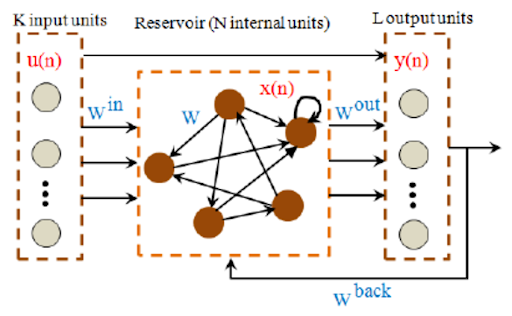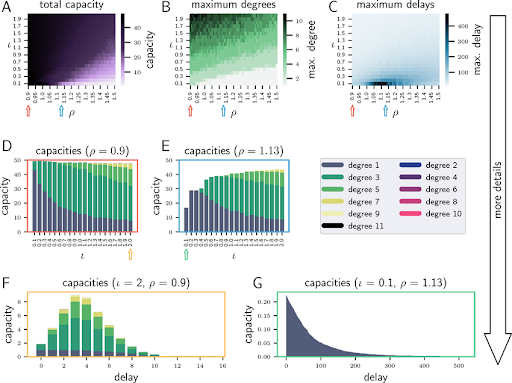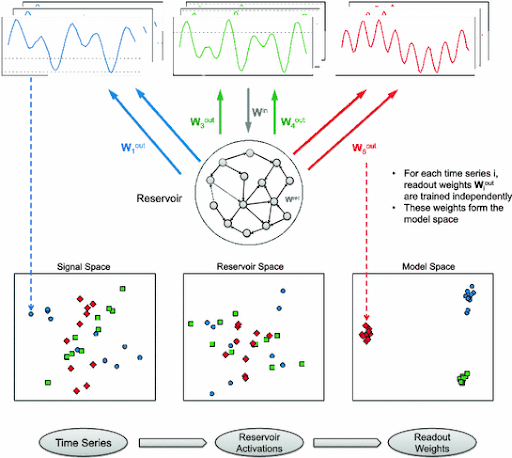
Hello pupils! Welcome to the next section of neural network training. We have been studying modern neural networks in detail, and today we are moving towards the next neural network, which is the Echo State Network (ESN). It is a type of recurrent neural network and is famous because of its simplicity and effectiveness.
In this tutorial, we’ll start learning with the basic introduction of echo state networks. After that, we’ll see the basic concepts that will help us to understand the work of these networks. Just after this, we’ll see the steps involved in setting the ESNs. In the end, we’ll see te fields where ESNs are extensively used. Let’s start with the first topic:

Introduction to Echo State Networks (ESNs)
The echo state networks (ESNs) are a famous type of reservoir computer that uses recurrent neural networks for their functionalities. These are modern neural networks; therefore, their working is different from the traditional neural networks. During the training process, this does not rely on the randomly configured "reservoir" of neurons instead of backpropagation, as we observe in traditional neural networks. In this way, they provide faster and better performance.
The connectivity of the hidden neurons and their weights are fixed and these are assigned randomly. This helps it provide temporal patterns. These networks have applications in signal processing and time-series prediction.
Basic Concepts of Echo State Networks (ESNs)
Before going into detail about how it works, there is a need to clarify the basic concepts of this network. This not only clarifies the discussion of the work but will also clarify the basic introduction. Here are the important points to understand here:
Reservoir Computing in ESN
The basic feature of ESN is the presence of the concept of computing reservoir. This is a hidden layer that has randomly distributed neurons. This random distribution makes sure that the input data is captured by the network effectively and does not overfit the specific pattern as is done in some other neural networks. In simple words, the reservoirs are known as the randomly connected recurrent network because of their structure. These reservoirs are not trained but play their role randomly in the computing process.
Comparing RNN with ESN
ESNs are members of a family of recurrent neural networks. The working of ESNs is similar to RNN but there are some distinctions as well. Let us discuss both:
- The RNN is a class of artificial neural networks that use sequential and temporal data for their work. The ESN has the same working principle; therefore, it can also maintain the memory of past responses.
- During the processing of RNN as well as the ESN, the order of the input elements affects the output.
- Both of these have long-term and short-term dependencies within the sequence; therefore, the role of sequence in these networks is important.

Now, here are some differences between these two:
ESN vs. RNN
The difference between the training approaches of both of these is given here:
- In the training process of RNN, all the work is done with backpropagation. This causes problems in the vanishing and exploding gradients. The ESNs have a fixed random recurrent weight matrix therefore, the structure is quite simpler than RNN because, here in the training, only output weights are adjusted.
- In RNN, all the weights, including the recurrent connections, are trainable. Whereas, in ESNs, the reservoirs are not only fixed but are randomly assigned during the process of initialization. During the processing, the calculations are done only with the neurons that are connected to the reservoirs. This not only makes it less complex but also lessens the processing time.
- In RNNs, the neurons in the network are fully connected but in ESNs, the concept of sparsity is present. According to this concept, each neuron is connected to a subset of the other neuron only. This makes the ESN more productive and simple.
Echo State Property in ESN
The ESN has a special property known as echo state property or ESP. According to this, the dynamics of the reservoirs are set in such a way that they have the fading memory of the past inputs. That means the structure of these neural networks must be created in such a way that it pays more attention to the new input concerning the memory. As a result, the old inputs will fade from memory with time. This makes it lightweight and simple.
Non-linear Activation Function in ESN
In ESNs, the reservoir’s neurons have a non-linear activation function; therefore, these can deal with complex and nonlinear input data. As mentioned before, the ESNs employ fixed reservoirs that help them develop dynamic and computational capabilities.
How Do Echo State Networks Work?
Not only the structure, but the working of the ESNs is also different from that of traditional neural networks. There are several key steps for the working of the ESNs. Here is the detail of each step:
Initialization in ESNs
In the first step, the initialization of the network is carried out. As we mentioned before, there are three basic types of layers in this network, named:
- Input layer
- Reservoir layer (hidden layer)
- Output layer
This step is responsible for setting up the structure of the network with these layers. This also involves the assignment of the random values to the neuron weights. The internal dynamics of the reservoir layers evolve as more data is collected in these layers.
Usage of Echo State Property
The echo state property of ESNs makes them unique among the other neural networks. Multiple calculations are carried out in the layers of the ESNs, and because of this property, the network responds to the newer inputs quickly and stores them in memory. Over time, the previous responses are faded out of memory to make room for the new inputs.
Input Processing in ESNs
In each step, the echo state network gets the input vector from the external environment for the calculation. The information from the input vector is fed into both the input layer and the reservoir layer every time. This is essential for the working of the network.
Reservoir Dynamics in ESNs
This is the point where the working of the reservoir dynamic starts. The reservoir layer has randomly connected neurons with fixed weights, and it starts processing the data through the neurons. Here, the activation function starts, and it is applied to the dynamics of the reservoir.
Updation of the Internal State
In ESNs, the internal state of the reservoir layer is updated with time. These layers learn from the input signals. The ESNs have dynamic memory that continuously updates the memory with the update in the input sequence. In this way, the internal state is updated all the time.
Training Process of ESNs
One of the features of ESNs is their simplicity of the training process. Unlike traditional neural networks, the ESNs train only the connection of the reservoirs with the output layer. The weights are not updated in this case but these remain constant throughout the training process.
Usually, a linear algorithm, such as linear regression, is applied to the output layer. This process is called teacher forcing.
Output Generation in ESNs
In this step, the output layer gets information from the input and reservoir layers. The output of both of these becomes the input of the output layer. As a result, the output is obtained based on the current time step of the reservoir layer.
Task-Specific Nature of ESNs
The ESNs are designed to be trained for the specific tasks such as:
- Time-series prediction
- Pattern recognition
- Signal processing
The ESNs are designed to learn from the relationship between the input sequence and the corresponding outputs. This helps it to learn in a comparatively simpler way.
Advantage of the Structure of ESNs
The above structure of the ESN helps them a lot to have better performance than many other neural networks. Some important points that highlight the advantage are given here:
Fast Learning with ESN
The structure of the ESNs clearly shows that these can learn quickly and more efficiently. The fixed reservoir weights allow it to learn at a rapid rate and the structure is also comparatively less expensive.
Absence of Vanishing Gradients
The ESNs do not have the vanishing gradient because of the fixed reservoirs. This allows them to work in the long-term dependencies in the sequential data. The presence of this vanishing gradient in other learning algorithms makes them slow.
Less Noise in ESNs
The ESNs are robust to the noise because of the reservoir layer. The structure is designed in such a way that these have better generalization of the unseen input data. This makes the structure easy and simple and avoids the noise at different steps.
Flexibility in the Structure of ESNs
The simple and well-organized structure of ESN allows it to work more effectively and show flexibility in working as well as in the structure. These can adopt the various tasks and data types throughout their work and training.
Applications of Echo State Networks
Businesses and other fields are now adopting neural networks in their work so that they can get efficient working automatically. Here are some important fields where echo state networks are extensively used:
Time Series Prediction with ESN
The ESNs are effective in learning from the data for time series prediction. Their structure allows them to effectively predict by utilizing the time series data; therefore, it is used in the fields like:
- Stock price prediction.
- Weather forecasting.
- Energy consumption prediction.
Signal Processing in ESN
The signal processing and their analysis can be done with the help of the echo state networks. This is because these can capture the temporal pattern and dependencies in the signal. This is helpful in fields like:
- Speech recognition
- Physiological signal analysis
- Studying the speech signals and biomedical signals.
These procedures are used for different purposes where the signal plays an important role.
Reservoir Computing Research with ESNs
There are different reservoir computing research centers where ESNs are widely used. These departments focus on the exploration of the capabilities of reservoir networks such as ESNs. Here, the ESNs are extensively used as a tool for studying the structure and working of recurrent neural networks.
Cognitive Modeling with ESNs
The ESNs are employed to understand aspects of human cognition such as learning and memory. For this, they are used in cognitive modeling. They play a vital role in understanding and implementing the complex behaviors of humans. For this, they are implemented in dynamic systems.
Control Systems and ESNs
An important field where ESNs are applied is the control system. Here, these are considered ideal because of their temporal dependencies. These learn from the control dynamic processes and have multiple applications like process control, adaptive control, etc.
Time Series Classification with ESNs
The ESN is an effective tool for time series classification. Here, the major duty of ESN is to classify the sequence data into different groups and subgroups. This makes it useful in fields like gesture recognition, where pattern recognition for movement over time is important.
Speech Recognition Using ESNs
Multiple neural networks are used in the field of speech recognition and ESN is one of them. The echo state network can learn from the pattern of the speech of the person and as a result, they can recognize the speaking style and other features of that voice. Moreover, the temporal nature of this network makes it ideal for capturing phonetic and linguistic features.
Echo State Networks in Robotics
The temporal dependencies of the ESN also make it suitable for fields like robotics. Some important tasks in robotics where temporal dependencies are used are robot control and learning sequential motor skills. Such tasks are helpful for robotics to adapt to the changes in the environment and learn from previous experience.
Natural Language Processing
The ESNs are used in natural language processing tasks such as language modeling, sentiment analysis, etc. Here, the textual data is used to get the temporal dependencies.
Hence, we have learned a lot about the echo state networks. We started with the basic introduction of the ESNs. After that, we saw the basic concepts of the ESNs and their connection with the recurrent neural network. We understood the steps to implement the ESNs in detail. After that, when all the basic concepts were clear, we saw the applications of ESNs with the points that make them ideal for a particular field. I hope the echo state networks are clear to you now. If you have any questions, you can contact us.






